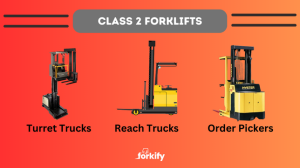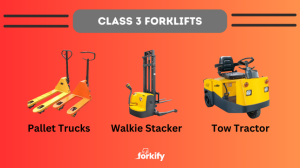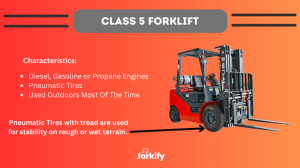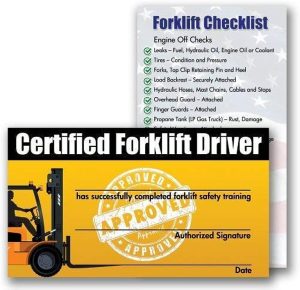Forklifts play a crucial role in material handling across various industries. This article demystifies forklift classes, guiding you through different types to help identify the right choice for your specific needs, ensuring efficiency and safety in your workplace.
Understanding Forklift Classification
Forklifts are divided into classes based on their design, power source, and application. This classification helps in understanding the capabilities and limitations of different forklift types.
For example, electric forklifts are often used indoors due to their zero emissions, while internal combustion forklifts are common in outdoor settings for their power and durability.
Factors Influencing Forklift Classification
Forklift classification is influenced by Six key factors, which are essential to understand when choosing the right forklift for specific tasks:
Power Source: The choice between electric, diesel, or propane power influences classification, with electric forklifts typically used indoors for their clean operation, and internal combustion engines preferred outdoors for greater power and durability.
Tire Type: Forklifts with cushion tires (solid rubber, suited for smooth surfaces) are classified differently from those with pneumatic tires (larger, air-filled, ideal for rough terrain), impacting their operational environment.
Load Capacity and Lift Height: Classifications vary based on a forklift’s maximum lift capacity and height, distinguishing light-duty indoor models from heavy-duty outdoor ones.
Manoeuvrability and Size: The design factors like size and manoeuvrability determine the forklift’s classification, affecting its suitability for environments like narrow warehouse aisles or spacious construction sites.
Specific Design Features: Unique features such as side-shifting masts or attachments influence classification, catering to specialised tasks like high-reach lifting or material handling in confined spaces.
Intended Environment and Application: Forklifts are classified based on their intended operational environment (indoor, outdoor, uneven terrain), ensuring that each class meets specific industry requirements for efficiency and safety.
The Importance Of Forklift Classes Across Industry
The choice of forklift class is critical across different industries, each with unique material handling requirements. For instance, warehouses with narrow aisles often opt for Class II forklifts, known for their manoeuvrability.
Selecting the appropriate forklift class enhances safety, boosts productivity, and makes for an all round more efficient material handling operation.
Having explored the fundamentals of forklift classes, their influencing factors, and their industrial importance, let’s now dive into each specific classification in more detail:
Find Your Perfect Forklift
Compare Quotes from Local Forklift Dealerships


Enter Requirements


We Find the Best Deal


Receive your Quote
Electric Motor Forklifts
Class I – Electric Motor Rider Trucks
Description: Class I forklifts are powered by electric motors and are commonly used for a variety of indoor tasks. They are known for their clean operation, making them ideal for environments where air quality is a concern.
Applications: These are widely used in warehouses, distribution centres, and other indoor settings where manoeuvrability and a lack of emissions are crucial.
Advantages: They offer a quiet operation with lower maintenance costs compared to internal combustion engines and are environmentally friendly.
Class II – Electric Motor Narrow Aisle Trucks

Description: Designed for operation in narrow aisles, Class II forklifts maximise space efficiency in storage areas.
Applications: Essential in settings like tight warehouse aisles, they are adept at handling pallets and transporting goods in confined spaces.
Advantages: Their compact design and exceptional manoeuvrability allow for efficient storage and retrieval in limited spaces, enhancing overall warehouse productivity.
Class III – Electric Motor Hand Trucks or Pallet Trucks

Description: Class III forklifts include electric pallet jacks and walkie stackers, used for short-distance material movement.
Applications: Ideal for loading and unloading materials from trucks and moving goods over short distances within facilities like retail environments and small warehouses.
Advantages: They are user-friendly, generally more affordable, and suitable for operations where full-sized forklifts are not necessary, offering flexibility and efficiency in material handling.
Internal Combustion Engine Forklifts
Class IV – Internal Combustion Engine Trucks (Cushion Tires)
Description: Class IV forklifts are equipped with internal combustion engines and cushion tires. They are designed primarily for indoor use, particularly on smooth surfaces.
Applications: These forklifts are commonly found in warehousing, distribution centres, and manufacturing facilities with concrete floors.
Advantages: The cushion tires offer a lower profile, allowing for easier manoeuvrability in confined spaces, and the internal combustion engines provide robust power for various lifting tasks.
Class V – Internal Combustion Engine Trucks (Pneumatic Tires)

Description: Class V forklifts have internal combustion engines and pneumatic tires, making them versatile for both indoor and outdoor use.
Applications: They are widely used in construction sites, lumber yards, and any environment where the terrain may be uneven or rough.
Advantages: The pneumatic tires provide better traction on various surfaces, and the powerful engines allow for handling heavier loads, making them suitable for a wide range of heavy-duty tasks.
Specialised Forklift Types
Class VI – Electric and Internal Combustion Engine Tractors
Description: Class VI forklifts include tow tractors, which are used for pulling loads rather than lifting. These can be powered by either electric motors or internal combustion engines.
Applications: They are often used in airports for luggage handling, in factories for towing heavy loads, or any industry requiring the movement of large quantities of materials over relatively long distances within a facility.
Advantages: These tractors are versatile in their towing capacity and can handle very heavy loads, making them essential in operations where traditional lifting is not required.
Class VII – Rough Terrain Forklift Trucks
Description: Class VII forklifts are designed for rough terrain with features like high ground clearance and robust tires. They are predominantly powered by internal combustion engines.
Applications: These are commonly used in outdoor environments like construction sites, lumber yards, and other off-road applications.
Advantages: With their rugged construction and powerful engines, they can manoeuvre over uneven terrain while carrying heavy loads, making them indispensable in construction and agricultural sectors.
Other Forklift Types
These forklift types don’t align with the standard classifications and each comes with unique licensing and safety requirements.
Scissor Lifts
Description: Scissor lifts are platforms capable of vertical movement to access high areas, supported by crisscrossing metal supports.
Applications: Used in facility maintenance, construction, and warehouses, ideal for tasks requiring elevation like painting, overhead installations, or inventory access.
Advantages: Provides stable vertical access, compact in design for easy manoeuvrability in tight spaces, and enhances safety for elevated work.
Cherry Pickers
Description: Also known as boom lifts, cherry pickers have a long, extendable arm or boom with a basket or platform at the end for lifting a person.
Applications: Commonly used for utility work, warehouse order picking, and construction, particularly for tasks requiring reach at variable heights and angles.
Advantages: Offers flexibility in horizontal and vertical movement, allows access to hard-to-reach areas, and improves safety for tasks at height.
Telehandlers
Description: Telehandlers feature a telescopic boom that can extend forwards and upwards, with attachments like buckets or pallet forks.
Applications: Versatile in construction and agriculture for lifting and moving materials over obstacles or onto higher levels.
Advantages: High lifting capacity, adaptable with various attachments for different tasks, and superior reach capabilities compared to standard forklifts.
These specialised forklifts, with their unique capabilities, require specific training and adherence to safety standards, ensuring efficient and safe operation in various industrial environments.
Choosing The Right Forklift For Your Needs
Choosing the right forklift for your business is a crucial decision that hinges on several factors: the working environment (including terrain and space constraints), the nature of the loads to be handled (weight, size, and shape), and the skill and licensing level of the operators.
Assessing these aspects helps in selecting a forklift which perfectly fits your needs whilst ensuring safety, efficiency, and productivity in your operations.
For a comprehensive guide on selecting the ideal forklift, you can refer to our buyers guide: The Forklift Buyers Guide
Licensing and Safety Considerations for Different Forklift Classes

Licensing and safety requirements vary by forklift class. Standard classes (I-V) generally require a basic forklift licence, while specialised classes like VI and VII demand specific training.
Safety training also differs based on the class’s unique risks and environments. Proper training for the specific forklift class used is essential for safe and efficient operation.
Final Thoughts
In conclusion, understanding the nuances of forklift classes and their associated licensing and safety requirements is essential. Matching the right forklift class to your specific material handling needs ensures both safety and efficiency.